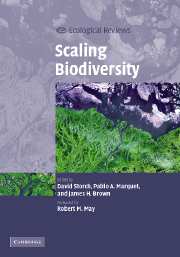Book contents
- Frontmatter
- Contents
- List of contributors
- Foreword by Robert M. May (Lord May of Oxford)
- Preface
- 1 Introduction: scaling biodiversity – what is the problem?
- PART I Spatial scaling of species richness and distribution
- PART II Alternative measures of biodiversity: taxonomy, phylogeny, and turnover
- PART III Scaling of biological diversity with energy and the latitudinal biodiversity gradient
- 11 Climate and diversity: the role of history
- 12 Inverse latitudinal gradients in species diversity
- 13 Regional-to-global patterns of biodiversity, and what they have to say about mechanisms
- 14 Recasting the species–energy hypothesis: the different roles of kinetic and potential energy in regulating biodiversity
- 15 Scaling species richness and distribution: uniting the species–area and species–energy relationships
- PART IV Processes, perspectives, and syntheses
- Index
- Plate section
- References
11 - Climate and diversity: the role of history
Published online by Cambridge University Press: 05 August 2012
- Frontmatter
- Contents
- List of contributors
- Foreword by Robert M. May (Lord May of Oxford)
- Preface
- 1 Introduction: scaling biodiversity – what is the problem?
- PART I Spatial scaling of species richness and distribution
- PART II Alternative measures of biodiversity: taxonomy, phylogeny, and turnover
- PART III Scaling of biological diversity with energy and the latitudinal biodiversity gradient
- 11 Climate and diversity: the role of history
- 12 Inverse latitudinal gradients in species diversity
- 13 Regional-to-global patterns of biodiversity, and what they have to say about mechanisms
- 14 Recasting the species–energy hypothesis: the different roles of kinetic and potential energy in regulating biodiversity
- 15 Scaling species richness and distribution: uniting the species–area and species–energy relationships
- PART IV Processes, perspectives, and syntheses
- Index
- Plate section
- References
Summary
Introduction
It has been known for over two centuries that the diversity of land plants, in the familiar sense of species richness, is not distributed evenly over the surface of the earth (von Humboldt, 1808). Similar patterns were soon established for terrestrial animals (Wallace, 1876) but it was a long time before our knowledge of marine organisms was sufficient to determine large-scale biogeographic patterns in the sea. Although humans had long exploited the nearshore and continental shelf seas for food and other resources, it was not until the pioneering oceanographic voyages of the late nineteenth and early twentieth century that we began to determine similar global patterns of marine biogeography (Angel, 1994, 1997). We now recognize that, as a broad generalization, diversity on land and in the sea attains its highest values in the tropics and is lowest at the poles, with temperate regions often intermediate (Gaston, 2000; Chown & Gaston, 2000).
Although these global scale (macroecological) patterns in diversity are dramatic, we still lack an agreed explanation for their cause. We can correlate these patterns with a range of environmental variables but ecology based solely on correlations is incomplete. We might be able to use such correlations to make predictions (Peters, 1983, 1991) but predictions without an underlying mechanistic understanding have limited usefulness because we lack knowledge of the conditions under which those predictions might break down.
- Type
- Chapter
- Information
- Scaling Biodiversity , pp. 225 - 245Publisher: Cambridge University PressPrint publication year: 2007
References
- 2
- Cited by



